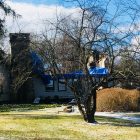Government
White Oak Shade Home Under Cease-and-Desist Has Curious Footnote in New Canaan History
|
The White Oak Shade home now under a cease-and-desist order after an unpermitted demolition of its second floor dates to about 1750, historic preservationists say, and appears originally to have belonged to a Canaan Parish family that earned a curious—and rather treacherous—footnote in the history of the town. According to New Canaan Historical Society files cited by Rose Scott Long, co-president of the New Canaan Preservation Alliance, the home at 251 White Oak Shade Road had been labeled at one time as the “William Reid, Sr. House.”
Records show that it has been renovated several times since the 18th Century, making it “difficult to discern what was original and what was fabricated to appear original,” Scott Long told NewCanaanite.com. One historical record also notes that the home at some point was “moved back from the road.”
A census records list unearthed by Scott Long indicates that in 1790—the year of the first census in the United States—the home was inhabited by a “William Reed, Jr.”
Turning back to the clock about a dozen years, to the American Revolutionary War—historians note that in Canaan Parish (recall that New Canaan, as we know it, wasn’t incorporated until 1801), one practice among patriots as well as Loyalists seeking to maximize value in trade was to drive cattle across Westchester County to trade with the British, who paid in coin rather than unreliable Continental paper money. (Mary Louise King notes in her “Portrait of New Canaan” history that Maj. Benjamin Tallmadge, among other heroic feats of battle during the war, in 1779 moved against that illicit trade.)
The year that Lord Cornwallis would surrender, in October, at Yorktown, Va.—1781—opened in Canaan Parish with “Samuel Cooke Silliman presiding over the trials of three men and a woman who had been trading with the enemy,” King writes.
